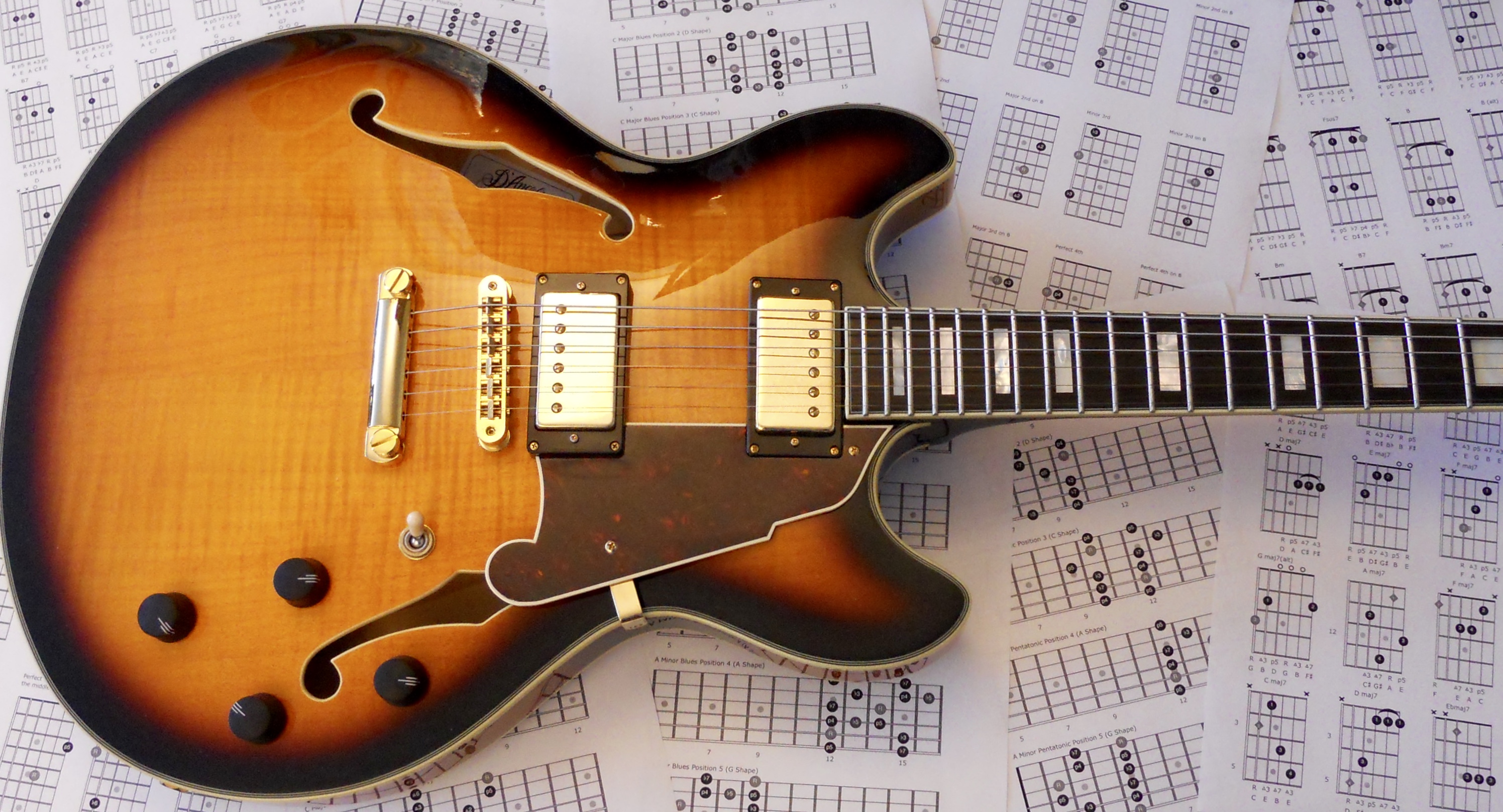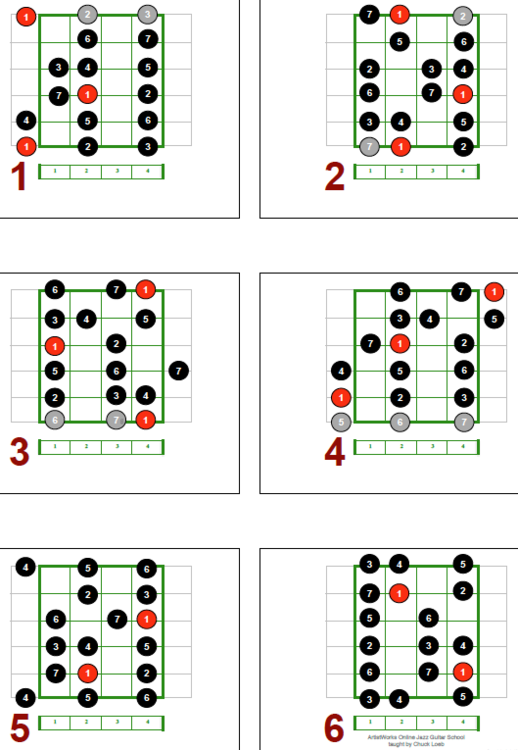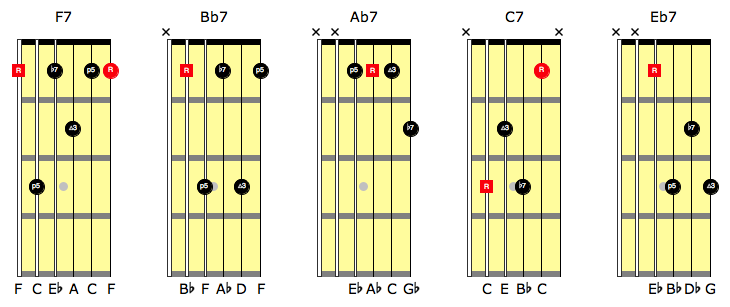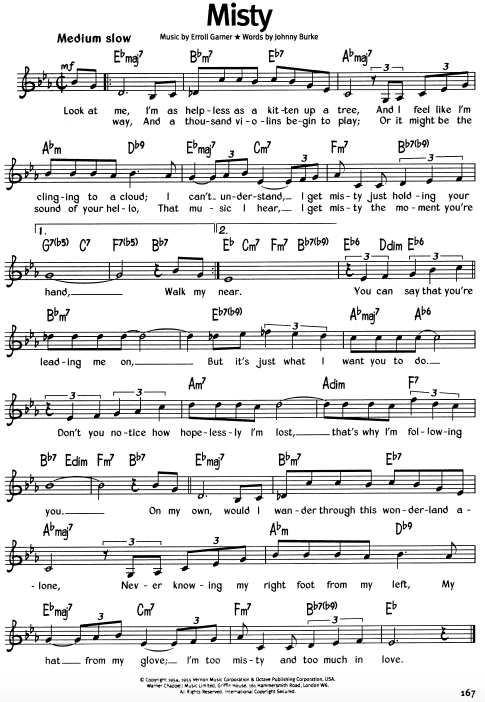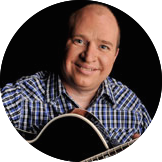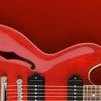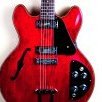-
Posts
309 -
Joined
-
Last visited
-
Days Won
36
Content Type
Profiles
Forums
Gallery
Events
Articles
Blogs
Downloads
Everything posted by V7#5b9
-
Actually, I was considering 5th Avenue CW Kingpin II HB, but the Sheraton-II Pro won for versatility. I find I prefer semi-hollow body guitars to fully hollow ones. As for an archtop I already have an entry level one. The Ibanez I mentioned previously is good enough for me. I prefer the Florentine cutaway, 12” fingerboard radius, SlimTaper neck shape and 24.75” scale. But, I think I’ll switch to roundwound strings. The flatwound strings sound kind of dull to my ear and lack sustain, but they do help with string noise. So, there’s always a trade-off somewhere. I also prefer lighter strings. The Ibanez is set up for jazz light gauge: 11-50. Having said that, I suspect the Godin’s quality is superior and the sound is very appealing. They should offer custom options.
-
More jazz guitar gear talk. This time Richie talks about 5 best jazz archtops under $1,000.
-
Good question: “Is buying the odd course/exercise really enough?” Over the years I’ve purchased whatever Steve would author plus some of his recommendations until the video series that includes Fretboard Workouts. I only got the Jazz Chords and I didn’t really need that, but I still wanted to show a little support. Now, I wouldn’t mind showing more support, but my needs have decreased substantially. I think that for students who have been at it for a while and accumulated a number of resources, an odd course/exercise may be all they need. It seems sort of a paradox that through this forum we keep promoting the old products the author is no longer compensated for. From that perspective, the idea of a revamped, expanded, and streamlined main course makes perfect sense. Steve hasn’t chimed in yet, so we don’t know what might suit him best, but I think that a good solution to all the previous suggestions would be a modular system that can be reassembled into many different combinations. These various combinations of units, e.g. Fretboard Workouts could answer both different curricular needs as well as individual interests. Steve could put out these units over time with suggested learning paths as well as allowing students to choose their own. The Praxis System is based on such approach minus videos. I think it would be beneficial for both new and old students. In a way, Steve is doing it already. Just keep answering the questions he posed in his initial post!
-
@Steve Krenz It would be helpful to know your take on the current replies as well as what your possible future plans are. Students could refocus their requests and suggestions based on your perspective. Would you care to chime in at this point?
-
@Eracer_Team-DougH I hear you Doug and I understand your point of view. I couldn’t care less for jazz when I was younger. I sort of grew up through this guitar learning journey and developed an appreciation for jazz guitar. So it’s not so much the jazz itself that I acquired taste for, but the guitar that led me to it. Now, it’s true that there are difficult voicings that require longer finger stretches, but there are also a lot of fairly easy jazz chords that don’t require long stretches. Steve’s Jazz Chords Fretboard Workout does NOT include a single chord that covers more than 4 frets. As a matter of fact, most cover 3, 2, or even 1 fret. Redo the main course? Sure, I could suggest a lot of things to be added. The question is how much is enough and how much is too much? Most students appear to take months to complete a single session. Do you think they would ever complete some mega course? Steve, being busy as he is, can hardly find the time to do a Fretboard Workout, not to mention a full-fledged course. I think people need better guidance on how to complete what they already have so that they could move on. I get the feeling that too many students get hung up on mastering this or that before moving on, and instead of temporarily circumventing an obstacle, they end up stalling. Then at a later date they may start up again. People want to play songs. Yes, of course, but what songs and in what style? How can you pick 10 or 20 songs that will appeal to everybody? It’s rather unlikely, don’t you think? What about copyrights? Forget it! Sheet music is for that. What people need are learning paths. For example, if you want to play country songs, you need to learn these guitar skills, acquire this amount of theoretical knowledge, and here are the resources. I generalize, but you know what I mean. Then, if you still need help figuring out how to play your favourite songs, you will need a resource that does just that. I think that to some extent Steve already has identified the student needs and that’s why he puts out the Fretboard Workout series. Although a revamped and expanded main course would probably be welcome, especially by new students, I’m not sure that it would be the best option at this point. There are tons of great supplemental resources out there. I think that redoing ‘Gibson’s skills house' series and making it available again is a better option and somewhat less work for Steve.
-
@Steve Krenz I understand you had made Genre Lesson Series on Jazz for ‘Gibson’s skills house’ that was never put out. You’ve done the Jazz Lesson 4 on a Live Lesson and that’s how I got the PDF. It indicates eight in-depth lessons on the foundations of Jazz guitar playing. I don’t know how much overlap there is with the lessons that were put out, e.g.”Jazz Basics, Jazz Turnarounds, The Ultimate Jazz Chord, Larry Carlton’s Super Arpeggio," etc. But, even if the students still have the pdfs, chances are they don’t have the videos. Why not combine, reshoot, perhaps expand all those lessons and/or even add some new material, into one series on jazz guitar and offer it as a package or course, rather than individual fretboard workouts? Anybody interested?
-
I don’t know if anybody here follows “The Jazz Guitar Channel” on YouTube, but “Gear Talk” in general usually sparks a comment or two. Richie provides tips on getting a great jazz tone out of your guitar and recommends jazz amps. Of course, there are other options and factors to consider, as well as personal preferences, but these tips are good guidelines. So let’s start with the video on getting a great jazz tone out of a solid body guitar. I got my Carvin Strat-like solid body with the intention of using it for jazz, so I do have a humbucker in the neck position, but nothing really special and I use D’Addario nickel wound, regular light gauge 10-46 strings. Believe it or not, but I can get a warmer and darker tone out of my solid body than I get from my Ibanez AKJ95 hollow body that has the Super 58 Humbucker in the neck position and D’Addario chromes, flat wound jazz light gauge 11-50 strings. As a matter of fact, I find the flat wounds kind of dull sounding and lacking sustain. Go figure! For picks I use Jim Dunlop: Jazz III, Ultex Jazz III and Big Stubby. Both my semi-hollows have great humbuckers with light gauge strings and coupled with my amps produce great jazz tone. I don’t find the need to go higher in string gauge. I get the tone I want so I’m not gonna fight heavier string gauges. Easy playability and access to higher register with cutaways are more important to me. Ok, let’s see the second video on jazz amps. For jazz I use two amps: Roland BluesCube Artist and/or Yamaha THR10C. Both work great with my selection of solid, semi, and hollow body guitars.
-
Thank you Wim. I know about Session 19. I was just thinking out loud in terms of pros and cons of the said approach. ?
- 9 replies
-
- prs
- live lesson
-
(and 1 more)
Tagged with:
-
@Steve Krenz Re: "All The Things You Are" I’m not a big fan of approaching jazz soloing from the perspective of the home key scale. It works fine with the chordal accompaniment, but ignoring the individual chords in the progression for the sake of simplicity may lead to playing lines that don’t outline the changes. In other words, the lines may lack implied harmony. Obviously, we can’t think that fast and we have to memorize the solo until we have a vast enough vocabulary and are able to pre-hear what we’re gonna play, and then perhaps we will be able to improvise in the true meaning of the word. I may be taking a more complicated approach to jazz than it needs to be, but I don’t mind. I’m just taking your advice: “Learn From Everywhere You Can.”
- 9 replies
-
- 1
-

-
- prs
- live lesson
-
(and 1 more)
Tagged with:
-
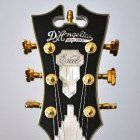
Session 7 - Barre Chords on the 6th String
V7#5b9 replied to NeilES335's topic in Gibson's Learn & Master Guitar
I beg to differ. ? I think the CAGED system simplifies the process of understanding the guitar fretboard and it does it at the highest level. Desi Serna incorporates it in his Fretboard Theory and both Steve Stine and Griff Hamlin have separate courses on the CAGED system, just to name a few teachers. I see it in the Three Note On A String Scales which Steve teaches in Session 17. It’s simply the way the fretboard is laid out. Why not understand it from its basic perspective? Beats me! ? Unless you are an advanced player like Steve, modes viewed from their root position, especially in jazz, are important too, because you need to know where your chord tones are when you solo, and chords do come from specific modes. Steve can do it from the perspective of modal superimposition (e.g. F mixolydian is the fifth mode of Bb so I’ll play Bb starting on the fifth note over the V chord) because from years of experience he’s come to understand the true underlying relationship of the notes he is playing to the chord of the moment. So yes, both CAGED and Modes do turn my crank. ? Will they make me a better sounding player? ? That’s not exactly a fair question, because that’s a matter of skill and technique, not theory. Another thing is that most courses out there are designed for guitar enthusiasts, hobbyists, or amateur musicians, not college students. Obviously, teachers don’t want to overwhelm their students with too much material. They break it down into smaller courses and teach what they think is absolutely necessary, because that’s what most students expect anyway. For example, the Circle of Fifths or Fourths is a great tool most musicians understand and use, yet it’s not covered in L&MG. ? Having made the case for CAGED and Modes, I will agree that not every player needs them. ? -

Session 7 - Barre Chords on the 6th String
V7#5b9 replied to NeilES335's topic in Gibson's Learn & Master Guitar
The D-shape Barre chords are based on the fourth string root. I’ve made a couple of entries in my Blog section, one on the conventional CAGED system and the other on the extended CAGED system. Here’s the LINK to the first one. -

Chuck Loeb - The 6 Positions Lesson
V7#5b9 replied to Randy120's topic in Guitar Playing & Technique
You’re welcome @Randy120. By the way, and this is for the benefit of anybody who may not realize it, the major scale or Ionian mode the six patterns indicate, can be turned into other scales quite easily. If you lower the 7th by one half step you get: 1-2-3-4-5-6-b7 or the Mixolydian mode. Then, by lowering the 3rd in Mixolydian by one half step you get: 1-2-b3-4-5-6-b7 or the Dorian mode, and so on. Ideally, you want to be able to visualize the patterns of all scale degrees as well as the embedded chord arpeggios which constitute the harmonic framework for soloing and improvisation. -

Chuck Loeb - The 6 Positions Lesson
V7#5b9 replied to Randy120's topic in Guitar Playing & Technique
@Randy120 It appears we discovered Chuck about the same time. As I wrote on the old forum, he turned me on to the BluesCube Artist. I even took his course for a while before switching to another one. In the introduction he talks about attending Berklee where he was introduced to the six positions. He later modified the fingerings slightly, but I can see that the patterns are primarily derived from the CAGED system. With a note of reflection Chuck talks about dropping out of college as he thought he had a bigger fish to fry. He also shared a fun fact about how he learned why Wes Montgomery played with his thumb. I see ArtistWorks put up this video on YouTube as an obvious promotion with some explanation of the positions, but very little detail. Hopefully, they won’t mind if I enhance this promotion by putting up the actual patterns. So, here they are: However, I recommend taking the entire course vs trying to learn bits and pieces from YouTube. Chuck deserves recognition as both great musician and teacher. His legacy will go on and you can learn a lot from him. Footnote: If you wonder why I abandoned Chuck’s course the answer is simple. You can navigate the fretboard with five (Howard Roberts), six (Chuck Loeb), or seven (Richie Zellon) patterns. The seven pattern system simply makes the most sense to me as there are seven notes in a major or minor scale, and it has nothing to do with superiority of one system over another. As a matter of fact, knowing multiple navigational systems has its benefits, but you probably need to select one as your default system. -

Session 7 - Barre Chords on the 6th String
V7#5b9 replied to NeilES335's topic in Gibson's Learn & Master Guitar
@RBT618, I certainly don’t want to contradict what has been stated so far, but since you are open to thoughts from anyone, I’d like to offer my humble opinion of the CAGED system. The system that is known today as CAGED is really an intrinsic part of the standard guitar tuning. Understanding the chord-scale-arpeggio relationships from the CAGED perspective is really the basis for mastering the fretboard. It’s not a difficult concept to grasp and it gives you the big picture a beginner may not see for a long time. Frankly, I would introduce CAGED conceptually as early as the open chords are taught, to show how the entire fretboard can be methodically deciphered in terms of the three basic elements: chords, scales and arpeggios. As each element of the puzzle is learned, having the big picture in mind helps put them back together again. CAGED is the standard way of breaking down the fretboard into manageable pieces. Some say CAGED sucks. Tom Hess is probably the biggest opponent of it. I think it’s a gross exaggeration. The 3-Notes-Per-String system he touts as being superior is advantageous in terms of economy picking and playing horizontally, but not so much when playing in position which allows for the best voice leading possible. Although the 3-Notes-Per-String method allows for 7 patterns and CAGED only 5, additional patterns can be derived. The Extended CAGED system as taught by Richie Zellon is basically the standard CAGED system with two more patterns to cover a whole 7-note scale. The fingering method employed results in consistency when playing both a scale and the arpeggio derived from it. Richie's heptatonic system of fingerings is the most versatile method I’ve come across so far. It allows for playing both vertically (in position) and horizontally (along the fretboard) using composite fingerings. Bottom line: There’s no single method that works perfectly in every situation. Therefore, the more shapes, patterns, and fingerings you’re familiar with, the more playing freedom you will have. -
@NeilES335, I understand your intention and thank you for taking the initiative, but you’ve created threads (Topics), not sub-forums. I see a problem with this approach. If there’s more than one topic or question for a particular session and there certainly will be, it will become tedious to get through the thread to the relevant info. If Steve is too busy, perhaps he could give you admin privileges to create the sub-forums for each course.
-
It sounds a lot like the story of some artists I know personally. It’s probably a story of the majority of small time artists these days. We’re just hobbyists having fun. They try hard to make a living as musicians. Regardless of the changing music world, most if not all new artists have to go through the growing pains. Few make it big, some make it small, and some don’t make it at all. But, I think the formula for success is still the same. Unless you’re an already established and successful artist, you gotta get out there and perform. You gotta do some covers, songs people love to hear, before they are willing to listen to and accept your own stuff. The Tin Pan Alley era was the golden age of non-performing songwriters who basically are the fathers of the Great American Songbook. They knew how to write great songs. In the 1960s, bands and songwriters who wrote and performed their own material took over the popular music charts. We all know who the successful ones are. They also knew how to write great songs. Over the last 3 decades or so there’s been an abundance of mediocre material written by formula to push sales. There are exceptions, of course, and maybe it’s an oversimplification, but today’s general mindset of instant gratification adds to the problem. Indie record labels seem to be the answer for aspiring artists who want to break the overused songwriting formula, but breaking through still requires the hard legwork.
-

Live Lesson: April 10, 2018 Jazz Guitar Mastery with Howard Alden!
V7#5b9 replied to Steve Krenz's topic in 2018 Live Lessons
I’ve watched the previous LL with Howard Alden more than once. I’ll gladly watch tonight’s show as well. I don’t really have any questions, but I thought Steve’s tips might go well with tonight’s live lesson. I got them from the old forum some time ago. They may prompt more questions from the viewers. @Steve Krenz, you may want to put these up on your new blog. SK’s Tips For Learning Jazz Standards “Jazz music has a core group of common songs called “standards” that all Jazz musicians need to be familiar with. These are the songs you’ll hear when you go to listen to Jazz at a club or restaurant. As a player, these are also the songs that you will play all the time. Most of these standards can be easily found in songbooks like “The Real Book”. Here are a few tips for learning these classic Jazz standards. These songs are more than simply catchy melodies. If you pay attention, they can also be the best learning tools you will find for understanding how Jazz works and how you can create great sounding improvised solos. 1) Start by Focusing on Three Classic Jazz Standards – a Medium-Tempo Classic, a Slow Ballad, and an Up-Tempo Tune. Eventually, you will know dozens of songs but the thought of this can be intimidating at first. So, start by learning three. Great medium tempo Jazz songs to start with would be songs like “Autumn Leaves” by Johnny Mercer or “Satin Doll” by Duke Ellington. Some good ballads to learn are “Misty” by Erroll Garner or “In the Wee Small Hours of the Morning” by David Mann. “I’ve Got Rhythm” by George Gershwin or “There Will Never Be Another You” by Harry Warren are great up-tempo songs to know. 2) Think About How the Chords Move. Jazz standards aren’t just random songs – they are classic studies in what makes a great chord progression. Analyze the chords that are used. What chord does it start out with? What chord does it end with and how is that ending approached by the chords that precede it? Identify the ii-V changes used to resolve to various chords within the song. Think carefully about how each chord is working within the song. In Jazz, every chord means something – it is either leading to another chord or being resolved to by something else. Understanding how these chords are functioning is a major step in knowing how to solo over them. 3) Learn the Melody. Be able to play the melody stylistically correct without much embellishment. Too often, inexperienced Jazz players treat the melody as a mere “suggestion” as a platform for their solo rather than giving it the importance it deserves as a melodic line that has stood the test of time. Notice how the melody moves and where it peaks in the phrase. Knowing the words of the song will help you to phrase the melody more musically. 4) When Soloing, View the Chords in Four Measure Segments. Most Jazz standards can be broken down into four measure phrases. Chords within these four measure segments are often relating to each other. Many times, players will solo based on one chord as it comes by, then solo over the next chord as it comes by rather then looking at a group of chords and trying to weave a line through each of the chords. As you solo, think of lines that weave in-between the changing notes of the chords in a phrase. This will create a much more musical solo. Learning Jazz standards is the core activity of the Jazz musician. As the great guitarist Tommy Emmanuel says, “People don’t want to hear you play scales or exercises, they want to hear songs.” If you’re familiar with and can play these timeless melodies then you’ll never be out of demand as a player.” SK’s Tips For Understanding The Real Book Volume 1 Play Along Tracks “The Real Book Play-Alongs are formatted a bit differently from standard play-alongs. They are designed to be a bit more like backing tracks to perform with. So often times there is an intro and a few variation in the chords from what is strictly notated in the written music. There doesn't seem to be a standard number of times that it goes through the song but they do follow a typical jazz form. INTRO (they may or may not have a 2 or 4 measure intro) MELODY OF THE SONG (Here you would play the melody of the song completely through the form. Typically this is an AABA form.) SOLO SECTION (Here you would solo over the chord changes for the entire form of the song. The background accompaniment gets a bit looser to feel more like a solo. This section, still over the entire AABA form, can be repeated several times.) MELODY OF THE SONG AGAIN (Then you go back to the main melody of the song - again, through the entire AABA form.) OUTRO/VAMP (The song might just end, or they may include a short outro or vamp section to the song.)”- 7 replies
-
- 1
-

-
- live lesson
- howard alden
-
(and 1 more)
Tagged with:
-
-
The old site is probably one huge database. I don’t think the L&MG part can be isolated. Even if there was a way of doing it and that part could be imported into the new database, chances are it would not show properly due to software incompatibility of both forums’ front ends. The only way is to copy and paste, but that would be time consuming. I guess individual members could take upon themselves to do it, but a larger number would be required to minimize the time factor. Some coordination of effort would be necessary as well. There is another aspect. Technically, one should ask Legacy for their consent. And what about individual posters? Shouldn’t they be asked? Anyway, I feel like I’m rambling. It’s probably best not to mess up the new forum with the old stuff. However, Steve could break up the L&M Course Questions into the individual sessions so that students could ask questions in the corresponding lesson section. Another option and probably more practical is to post a question with the session number in the title and tag it accordingly so that it could be easily searchable. This way Steve won’t have to do the break-up and each course section will get populated gradually.
-

Session 11 - Pentatonic Scales
V7#5b9 replied to NeilES335's topic in Gibson's Learn & Master Guitar
Well done Neil! I’ll second Wim’s suggestion. Misty is a great standard to begin with. I know it’s copyrighted material, but it’s been over 60 years, so what the heck? It’s a slow piece. First, listen to Frank Sinatra’s rendition several times. Then follow the sheet music with lyrics. I think the combination of standard notation and lyrics conveys the mood better and helps with the melody. -
@Blue Dog About the four chords that killed the Pop music. I totally get it, but let’s not forget that from the functional harmony standpoint in tonal music, that’s all there’s to it. Yes, the 1-4-5-6 will get boring quickly if that’s all you play, but any progression no matter how sophisticated, at its core, boils down to the three basic functional elements: tonic, subdominant, and dominant: the 1-4-5. The other chords in a key function as either 1, 4, or 5. You can reharmonize the 1-4-5 by including the relative minor or vice versa, add passing and approach chords, using modal interchange (borrowing chords from parallel minor or vice versa), using secondary dominants, substitution chords, modulate to another key, use inversions, but at its core the progression pertaining to any specific key will be some combination of the 1-4-5. Bottom line: we can scoff at the simplicity of 1-4-5-6 as long as we understand it. A newbie might think they should avoid the progression altogether and wonder why every teacher begins the harmony lesson with the 1-4-5 progression.
-
@NeilES335 I like the idea of the regional sub-forum. Have you discussed it with Steve yet?
-

Free Jazz Chords Supplemental Resource
V7#5b9 replied to V7#5b9's topic in Jazz Chords Fretboard Workouts
The short answer is because in the context of jazz full Barre chords contain too many redundant notes. But, that may not be enough, so let me elaborate a bit. Jazz chords are derived from four part structures or the 7th chords that are played on various string sets. Those 7th chords are then modified to add colour. The 3rd and 7th are the primary guide tones that define the chord’s quality, e.g. minor or major so you don’t omit or change them. The root and the 5th are expendable and are used to turn them into extensions, alterations or a combination of both. From there you can add another tone or double an existing one. In the jazz context the 7th chords are really only a means to an end, and you want to play them with extensions and alterations. When you play solo as in chord melody arrangement, you may want to use fuller chords, but when you play with an ensemble or a backing track, you need to use leaner chords to leave room for the bass and even keyboard.- 12 replies
-
- 3
-

-

-
- string sets
- jazz chords construction
-
(and 1 more)
Tagged with:
-
I would analyze this progression in C from the functional harmony standpoint. In tonal harmony based on major and minor keys the most important functions of the chords are subdominant, dominant, and tonic (SDT). They are usually represented by scale degrees IV, V, and I, but other degrees can be substituted for them as well, e.g. ii for IV. When played in that given order (IV-V-I), they constitute what is traditionally known as perfect cadence. Your example in the key of C: C Dm G Cm Dm Cm C I ii(IV) V i(I) ii(IV) i(I) I C chord is the tonic. Dm is the ii chord in the key of C, but it also functions as subdominant. G is the V chord in the key of C so it functions as dominant. From G, you go back to the tonic, but to create more interest you turn it into the minor version. You also can look at it from the modal interchange perspective and borrowing the chord from the parallel minor key. From Cm you go to Dm functioning as the IV chord again, and finally you go back to the tonic preceded by its minor version. A typical progression where a major chord is followed by its minor version deals with the IV chord, e.g. G-D-C-Cm-G. By the way, the IV to I movement constitutes the plagal or amen cadence. Again, you can look at it from the modal interchange perspective: Cm chord being borrowed from G minor - the parallel scale to G major. The Beatles used IV-iv in I Call Your Name, In My Life, When I’m Sixty-Four, etc.
-
I don’t know if anybody remembers, but I had posted about this course on the previous forum. I have the original course on DVDs, and since I've received a huge discount on this new edition with online access, I got it as well. Check it out if you’re interested! Here’s the LINK.

